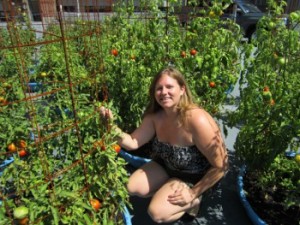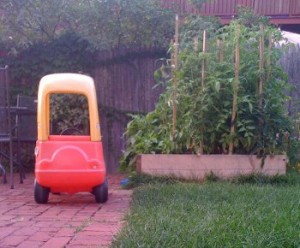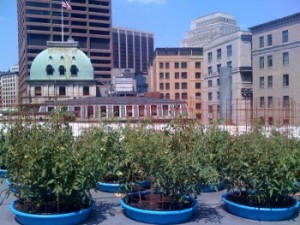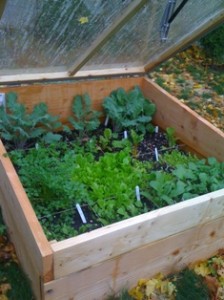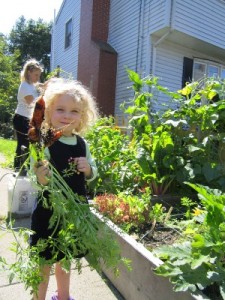by Jessie Banhazl
Incorporating vegetables into the urban landscape is not as difficult as it may seem. As with ornamental and perennial plants, placement, light, and spacing between plants are critical to the success of a vegetable garden. What is great about working in urban spaces is that you can take an untraditional approach to vegetable production by installing raised-beds or using containers anywhere on your property that receives at least four and a half hours of light.
At Green City Growers (GCG), we’ve installed garden beds on parking spaces, rooftops, decks, and a variety of other random locations that happen to have the most light on a property. As a professional vegetable gardener, I’ve identified a few simple guidelines for a successful vegetable garden when space and light are tight.
Containers, Raised-beds, or In-ground Planting
Choosing your vehicle for vegetable production is going to depend on the space you have to work with. If the sunniest place on the property is a driveway, deck, or a small area, then raised-beds can optimize that space and easily turn a non-garden space into a garden. Raised-beds are also appropriate for situations where the permanency of growing in the ground seems like too much of a commitment, as the beds can always be moved or removed. (This can be a big selling point for businesses and corporate sites.)
Raised-beds and containers are also an extremely helpful means of growing in spaces that have medium to high levels of lead in the soil. Unfortunately, this accounts for many of the sites we work with in the Boston area. To mitigate this problem, we put a few layers of weed block and hardware cloth on the bottoms of the beds to prevent the root systems from growing into the contaminated soil below the bed.
In-ground vegetable patches are great if you have healthy soil and ample space. We typically don’t recommend in-ground planting unless there is 100 sq. ft. or more of space available, and it’s a totally different game when it comes to installation. Again, unfortunately, we don’t often see over 100 sq. ft. of space available for planting in urban areas.
Look for the Sun
It’s best for vegetable production to find the sunniest garden location you can. While not all vegetables necessarily need full sun, you can always create shade with row cover or use taller plants to shade the heat-adverse lettuces and greens. The best way to identify where the most sun is in your yard is to use a compass. Line yourself up with north behind you and look up. As you walk through your site, look for as much blue sky as possible above you, and also to your left (east) and right (west). One trick I use is to compartmentalize the sky into those three areas: east, straight up, and west. I can estimate that each third of the sky, if unobscured, would provide approximately four to five hours of light. You don’t need the full day of sun for vegetable production, but the more sun the better.
I also try to check for shade creators, like houses and trees, above where a garden bed will be planted, and also to the east and west (left and right). Remember that the sun gets lower in the southern sky in the fall, winter, and spring, so anything directly in front of where you are standing (such as the house), will likely block a lot of the sun in both fall and spring.
If understanding the compass orientation seems too complicated on-site (sometimes light can be tricky to decipher when objects are partially blocking light during part of the day), I recommend observing the yard over the course of the day. Note when the space or spaces where you plan on putting the garden get sun and when they are shaded. Some gardens are better suited for fall or early spring production than for summer, due to shade creators that change depending on the time of year and position of the sun in the sky. At GCG, we use a tool called a Solar Pathfinder, which shows the sun’s trajectory at different times of day through the seasons. It’s a professional tool so it’s a bit pricey for a homeowner, but could be a worthwhile investment for a landscape professional.
Choose Your Plants
In terms of plants and how much sun they like, certain plants can handle less sun than others and still be productive. You ideally want as much light as possible, but sometimes sunlight is limited. Use the following basic guidelines to determine the amount of sun various vegetables need for success:
6+ hours of sun: fruiting crops (tomatoes, zucchinis, cucumbers, eggplants, peppers, etc.), basil, and rosemary.
4½ – 6 hours of sun: leafy greens, lettuces, perennial herbs like oregano and mint, chives, and thyme, root vegetables, onions, and garlic.
Also, keep in mind that certain crops can do well into the cold weather in the spring and fall while others will not succeed. If the vegetable plant can fare well with lower light, it often also does well in the cold. Kale, collards, chives, greens/lettuce, and root crops can stand a light frost, and should do well late into the season. We use cold frames to extend the growing season deep into December, and to keep plants alive over the winter for an early spring harvest. (Cold frames can extend the growing season by up to three months!) Most information you need to know in terms of light requirements and cold hardiness should be on the seed packet or in a seed catalog.
Every yard is different, and often even if there are trees blocking some light, it can filter through the leaves and give the garden additional light over the course of the day. If you feel like you get at least four hours of sun in a spot in the yard, I recommend trying vegetables on a small-scale. You might try a 4 ft. by 4 ft. raised-bed or containers, and see how your first year of production goes. After a growing season, you should be able to identify what is working and what isn’t, which will vary from yard to yard.
How Many Plants?
Once you’ve picked the best spot in the yard, what exactly should you plant? A good rule of thumb is to make sure whoever is eating from the garden is realistic about how much they intend to eat of what is planted. We often get clients who are really, really excited about tomatoes and plant six or more tomato plants, only to be totally overwhelmed by the yield. It sometimes takes a season to get this right, and depending on the year, some plants are more or less productive than previous years because of the growing season’s conditions. I recommend looking up basic yield statistics for the vegetable plants you are interested in growing to make sure you don’t over-commit yourself or your client to too much of a good thing.
To space plants, we follow the square foot gardening method. We at GCG love square foot gardening as a system for planting as much as you possibly can in a small space. Unlike row planting (like a farm), the key to square foot gardening is planting each crop as tightly as possible within a square foot of space, while making sure you don’t shade out any of your crops.
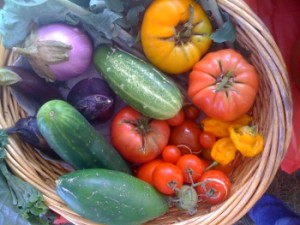
Placing tall plants so they do not shade shorter plants can yield a great variety of edibles in a small space.
Certain vegetable plants, like tomatoes, can get as tall as six or seven feet, while radishes and greens mix often grow no more than 6 to 12 inches above the soil. Make sure to plant the tall plants, as well as anything you can make grow vertically (like cucumbers, winter squashes, or pole beans) in the north side of the bed. We usually call these plants Alpha veggies because they take priority in terms of placement and have the ability to ruin a good intensively grown garden by shading out everything beneath them if mistakenly planted on the southern side of the bed. Beta plants include peppers, eggplants, leafy greens, and anything else that can grow pretty large, but doesn’t outgrow the tomatoes or vining crops. Plant Betas to the south of the Alphas. The southernmost plants will be greens, bush beans, herbs, and anything else that stays lower to the soil. In the end, the garden should have a bit of a staircase look to it, with the shorter plants on the south side, working their way up in height priority to the trellised, taller vegetables.
Proximity to the House
My final (well, not final, I could go on forever about vegetables!) tip addresses the placement of the bed in relation to the house. We often have requests to place garden beds in the back corner of the property, or to hide the garden from sight. I’m not sure where the apprehension about putting gardens in sight comes from, but it’s definitely an issue. Raised-beds can be gorgeous and contained; they can even be stained to match the house using a non-toxic paint.
I’ve had to go to battle over certain locations on a property because the space with the ideal light and distance to the water source (also something to take into consideration) was in a location that was not considered ideal either because it was in the front yard, or visible through a window. Here is my argument against these hesitancies: If you hide your garden from sight, you are much less likely to use the vegetables you are growing. Without the day-to-day connection to the plants, it is often easy to forget that you, in fact, have a vegetable garden that is hard at work yielding edible, delicious produce for you to use in your kitchen. Also, gardens in the front yard are an incredible conversation piece. All of our clients who have them in visible locations can tell you that the conversations started and engagement from people walking by is incredibly cool. (This includes me; I live right on the edge of a school property.) And it’s great to be a part of something people get excited about.
I wish you luck in working with edibles. It’s a rewarding experience to put effort into growing plants that not only look great, but give you something in return that is usable and usually better than its equivalent at the market.
About the Author
Jessie Banhazl is the owner of Green City Growers, a Somerville-based, backyard farming business specializing in raised-bed and cold frame installations. GCG also provides garden maintenance and education for residential, business, restaurant, and school locations. Jessie serves on the ELA Board of Directors. For more information on GCG, or to contact Jessie, go to www.growmycitygreen.com.

